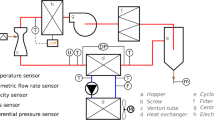Abstract
An experimental study was conducted to investigate the effects of air-side fouling and cleaning on the performances of various condenser coils used in unitary air-conditioning systems. A total of six condenser coils with different fin geometry and row number were tested. Performance tests were performed at three different conditions: clean-as-received, after fouling, and after cleaning. In all cases, it was observed that the fouling was mostly confined to the frontal face of the heat exchanger as reported in the previous investigations. The amount of deposited dust was more dependent on fin geometry for the single-row heat exchangers than for the double-row heat exchangers. The predominant effect of fouling was to cause a more significant increase in air-side pressure drop than a degradation in heat transfer performance. For the single-row heat exchangers, the pressure drop increased by 28 to 31%, while the heat transfer performance decreased by 7 to 12% at the standard air face velocity of 1.53 m/s depending on fin shape. For the double-row heat exchangers, the pressure drop increased by 22 to 37%, and heat transfer performance decreased by only 4-5% at the same air face velocity. Once the contaminated coils were cleaned according to the given cleaning procedure the original performance of the heat exchangers could almost be recovered completely. The pressure drop could be restored within 1 to 7% and the heat transfer performance could be recovered to within 1 to 5% of the originally clean heat exchangers. Therefore, it is concluded that a periodic application of the specified cleaning technique will be effective in maintaining the thermal performance of the condenser coils.
Similar content being viewed by others
Abbreviations
- A :
-
Total surface area [m2]
- C p :
-
Constant-pressure specific heat [J/kg.K]
- h :
-
Enthalpy [J/kg] or convective heat transfer coefficient [W/m2-K]
- m :
-
Mass flow rate [kg/s]
- ΔP :
-
Pressure drop [Pa]
- Q :
-
Heat transfer rate [W]
- R f :
-
Air-side fouling factor [m2K/W]
- R m :
-
Metal thermal resistance of external fins and tubes [K/W]
- ΔT m :
-
Log mean temperature difference
- T :
-
Temperature [°C]
- U :
-
Overall heat transfer coefficient [W/m2.K]
- V :
-
Air flow rate [m3/s]
- W f :
-
Weight of dust captured in the filter [kg]
- W t :
-
Total amount of dust sprayed from the dust injector [kg]
- Ф:
-
Humidity ratio
- ξf :
-
Efficiency of filter [%]
- η:
-
Fin efficiency
- v :
-
Specific volume of wet air [m3/kg]
- a :
-
Air-side
- avg :
-
Average
- f :
-
Fin or filter
- i :
-
Inlet
- o :
-
Outlet
- n :
-
Nozzle
- w :
-
Water-side
References
ASHRAE,ASHRAE Handbook 1998 Fundamentals. Atlanta, GA, 1998.
Bott. T. R. and Bemrose, C. R., 1983, “ Particulate Fouling on the Gas-side of Finned Tube Heat Exchangers,”J. of Heat Transfer, ASME, Vol. 105, pp. 178–183.
Bott, T. R., 1981. The fouling of Heat Exchangers, Elsevier, Amsterdam, The Netherlands.
Breuker, M. S. and Braun, J. E., 1998, “ Common Faults and Their Impacts for Rooftop air Conditioners,”International Journal of Heating, Ventilating, Air-Conditioning and Refrigerating Research, Vol. 4, No. 3, pp. 303–318.
Bultman, D. H., Burmeister, L. C. Bortone, V. and TenPas, T. W., 1993, “ Vapor-compression Refrigerator Performance Degradation due to Condenser Air Flow Blockage,”American Society of Mechanical Engineers (93-HT-34), published by ASME, pp. 1–13.
Cowell, T. and Cross, D. A., 1981, “ Air-side Fouling of Internal Combustion Engine Radiators,”SAE Trans., Vol.89, paper No. 801012, pp. 3179–3188.
Marner. W., 1990, “ Progress in Gas-side Fouling of Heat-transfer Surfaces,”Applied Mechanics Review, Vol. 43, No. 3, pp. 35–66.
Suitor, J. W., Marner, W. J. and Ritter. R. B., 1977, “ The History and Status of Research in Fouling of Heat Exchangers in Cooling Water Service,”The Canadian J. of Chem. Eng., Vol. 55. pp. 374–380.
Taborek, J., Aoki, T., Ritter, R. B., Palen, J. W. and Knudsen, J. G., 1972, “ Fouling: The Major Unsolved Problem in Heat Transfer,”Chermical Engineering Engineering Progress, Vol. 68, pp. 59–67.
Zhang, G, Bott, T. R. and Bemrose, C. R., 1990, “ Finned Tube Heat Exchanger Fouling by Particles,”Proc. of the 9th Int. Heat Transfer Conf, Vol.5, pp. 115–120.
Author information
Authors and Affiliations
Corresponding author
Rights and permissions
About this article
Cite this article
Pak, B.C., Baek, B.J. & Groll, E.A. Impacts of fouling and cleaning on the performance of plate fin and spine fin heat exchangers. KSME International Journal 17, 1801–1811 (2003). https://doi.org/10.1007/BF02983611
Received:
Revised:
Published:
Issue Date:
DOI: https://doi.org/10.1007/BF02983611




